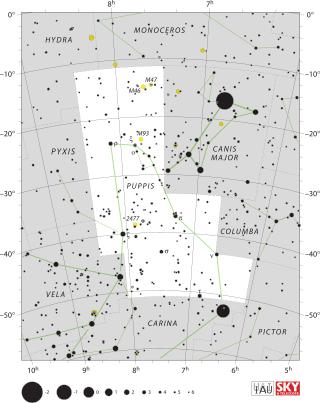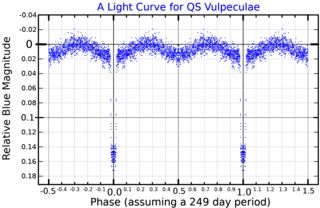Related Research Articles

Albireo is a double star designated Beta Cygni. The International Astronomical Union uses the name "Albireo" specifically for the brightest star in the system. Although designated 'beta', it is fainter than Gamma Cygni, Delta Cygni, and Epsilon Cygni and is the fifth-brightest point of light in the constellation of Cygnus. Appearing to the naked eye to be a single star of magnitude 3, viewing through even a low-magnification telescope resolves it into its two components. The brighter yellow star, itself a very close binary system, makes a striking colour contrast with its fainter blue companion.

Theta Antliae is the Bayer designation for a binary star in the southern constellation of Antlia. The pair have a combined apparent visual magnitude of +4.78; the brighter component is magnitude +5.30 while the secondary is +6.18. Based upon parallax measurements, it is located at a distance of around 430 light-years from Earth.
45 Cancri is a binary star system in the zodiac constellation of Cancer, located 680 light-years away from the Sun. It has the Bayer designation A1 Cancri; 45 Cancri is the Flamsteed designation. It is visible to the naked eye as a faint, white-hued star at an apparent visual magnitude of 5.62. The pair form a double-lined spectroscopic binary with an orbital period of 2.76 years and an eccentricity of 0.46. They are drifting closer to the Earth with a heliocentric radial velocity of −6 km/s.
Nu1 Canis Majoris (ν1 Canis Majoris) is a binary star in the constellation Canis Major. It is visible to the naked eye with a combined apparent visual magnitude of 5.7. Based on parallax shift of 12.366 mas as seen from our orbit, this system is approximately 264 light years from the Sun.
3 Centauri is a triple star system in the southern constellation of Centaurus, located approximately 300 light years from the Sun. It is visible to the naked eye as a faint, blue-white hued star with a combined apparent visual magnitude of 4.32. As of 2017, the two visible components had an angular separation of 7.851″ along a position angle of 106°. The system has the Bayer designation k Centauri; 3 Centauri is the Flamsteed designation. It is a suspected eclipsing binary with a variable star designation V983 Centauri.

Gamma Persei is a binary star system in the constellation Perseus. The combined apparent visual magnitude of the pair is +2.9, making it the fourth-brightest member of the constellation. The distance to this system is of roughly 221 light-years with a 1% margin of error. About 4° to the north of Gamma Persei is the radiance point for the annual Perseid meteor shower.

Tau Puppis, Latinized from τ Puppis, is a star in the southern constellation of Puppis, near the southern constellation boundary with Carina. It is visible to the naked with an apparent visual magnitude of +2.95 and is located at a distance of about 182 light-years from Earth. The variable radial velocity of this system was detected by H. D. Curtis and H. K. Palmer in 1908, based on observations made at the D. O. Mills Observatory. It is a spectroscopic binary star system, with the presence of the secondary component being revealed by the shifts of absorption lines in the spectrum resulting from the Doppler effect. The two components orbit each other with a period of 1,066.0 days and a low eccentricity of 0.090.

Zeta Cygni is a binary star system in the northern constellation of Cygnus, the swan. It has an apparent visual magnitude of 3.26 and, based upon parallax measurements, is about 143 light-years away.
39 Cygni is a binary star system near the southern border of the northern constellation of Cygnus, approximately 270 light years away from Earth. It is visible to the naked eye as an orange-hued star with an apparent visual magnitude of 4.43. The system is moving closer to the Sun with a heliocentric radial velocity of −15 km/s.

22 Vulpeculae is a binary star system in the northern constellation Vulpecula. Based on its parallax, it is located some 1,490 light-years away, and it has an apparent magnitude of about 5.2, making it visible to the naked eye. The system is moving closer to the Earth with a heliocentric radial velocity of −23 km/s.

ξ Cygni is a spectroscopic binary star in the constellation Cygnus, made up of a K-type supergiant star (primary) and an A-type star (secondary). Its apparent magnitude is 3.73, making it readily visible to the naked eye, and it is located around 350 parsecs (1,100 ly) away.

Phi Cygni, Latinized from φ Cygni, is a binary star system in the northern constellation of Cygnus. It is faintly visible to the naked eye with an apparent visual magnitude of 4.70. The annual parallax shift is 12.25 mas as measured from Earth, which yields a distance estimate of around 266 light years. It is moving further from the Sun with a radial velocity of +4.5 km/s.

47 Cygni is a triple star system in the northern constellation of Cygnus, and is located around 4,000 light years from the Earth. It is visible to the naked eye with a combined apparent visual magnitude of 4.61. The system is moving closer to the Earth with a heliocentric radial velocity of −4.6 km/s.

59 Cygni is a multiple star system in the northern constellation of Cygnus, located roughly 1,300 light years away from Earth. It is visible to the naked eye as a blue-white hued star with a combined apparent visual magnitude of 4.74.
μ Cygni, Latinised as Mu Cygni, is a binary star system in the northern constellation of Cygnus. It is visible to the naked eye as a faint point of light with a combined apparent visual magnitude of 4.49. The system is located 72 light years distant from the Sun, based on parallax, and is drifting further away with a radial velocity of +17 km/s.

Chi2 Hydrae, Latinised from χ2 Hydrae, is a binary star system in the equatorial constellation of Hydra. Based upon an annual parallax shift of 4.6 mas as seen from Earth, it is located roughly 685 light years from the Sun. It is visible to the naked eye with a combined apparent visual magnitude of about 5.7.

31 Cygni, also known as ο1 Cygni, Omicron1 Cygni, ο2 Cygni or V695 Cygni, is a ternary star system about 750 light years away in the constellation Cygnus.

68 Cygni is the Flamsteed designation for a star in the constellation Cygnus. Located approximately 690 parsecs (2,300 ly) distant, the star is a hot blue giant of spectral type O7.5IIIn( ), a massive star that is likely currently expanding to become a supergiant. The star is surrounded by a ring-shaped nebula named S 119.

RW Cygni is a semiregular variable star in the constellation Cygnus, about a degree east of 2nd magnitude γ Cygni. Its apparent magnitude varies between 8.05 and 9.70 and its spectral type between M3 and M4.

SU Cygni is a triple star system in the northern constellation of Cygnus, abbreviated SU Cyg. The primary component of the system is a classical Cepheid variable with a period of 3.8455473 days. The changing luminosity of this star causes the system to vary in brightness from a peak apparent visual magnitude of 6.44 down to magnitude 7.22 over the course of its cycle. The distance to this system is approximately 3,200 light years based on parallax measurements. It is a member of the Turner 9 open cluster of stars.
References
- 1 2 3 4 5 6 7 Brown, A. G. A.; et al. (Gaia collaboration) (August 2018). "Gaia Data Release 2: Summary of the contents and survey properties". Astronomy & Astrophysics . 616. A1. arXiv: 1804.09365 . Bibcode: 2018A&A...616A...1G . doi: 10.1051/0004-6361/201833051 .
- 1 2 3 4 5 6 7 8 Ginestet, N.; Carquillat, J. M. (2002). "Spectral Classification of the Hot Components of a Large Sample of Stars with Composite Spectra, and Implication for the Absolute Magnitudes of the Cool Supergiant Components". The Astrophysical Journal Supplement Series. 143 (2): 513–537. Bibcode:2002ApJS..143..513G. doi: 10.1086/342942 .
- 1 2 3 "Sixth Catalog of Orbits of Visual Binary Stars". United States Naval Observatory. Archived from the original on 2017-08-01. Retrieved 2020-02-29.
- 1 2 3 4 5 6 7 8 Eggleton, Peter P.; Yakut, Kadri (2017). "Models for 60 double-lined binaries containing giants". Monthly Notices of the Royal Astronomical Society. 468 (3): 3533. arXiv: 1611.05041 . Bibcode:2017MNRAS.468.3533E. doi: 10.1093/mnras/stx598 . S2CID 119476544.
- 1 2 Soubiran, Caroline; Le Campion, Jean-François; Brouillet, Nathalie; Chemin, Laurent (2016). "The PASTEL catalogue: 2016 version". Astronomy & Astrophysics. 591: A118. arXiv: 1605.07384 . Bibcode:2016A&A...591A.118S. doi:10.1051/0004-6361/201628497. S2CID 119258214.
- ↑ "* 9 Cyg". SIMBAD . Centre de données astronomiques de Strasbourg . Retrieved 2020-02-28.